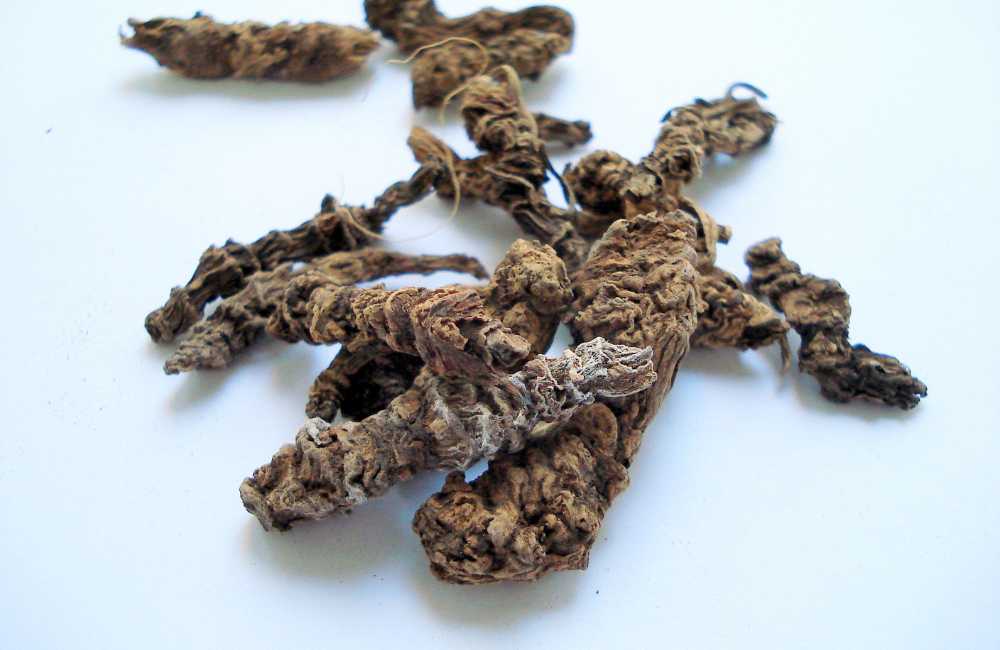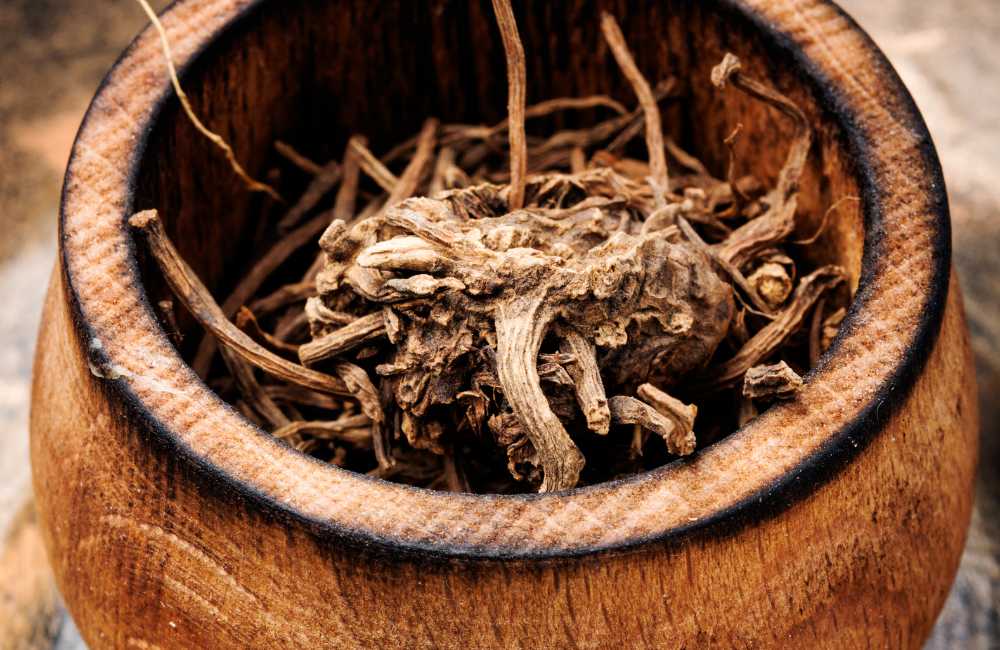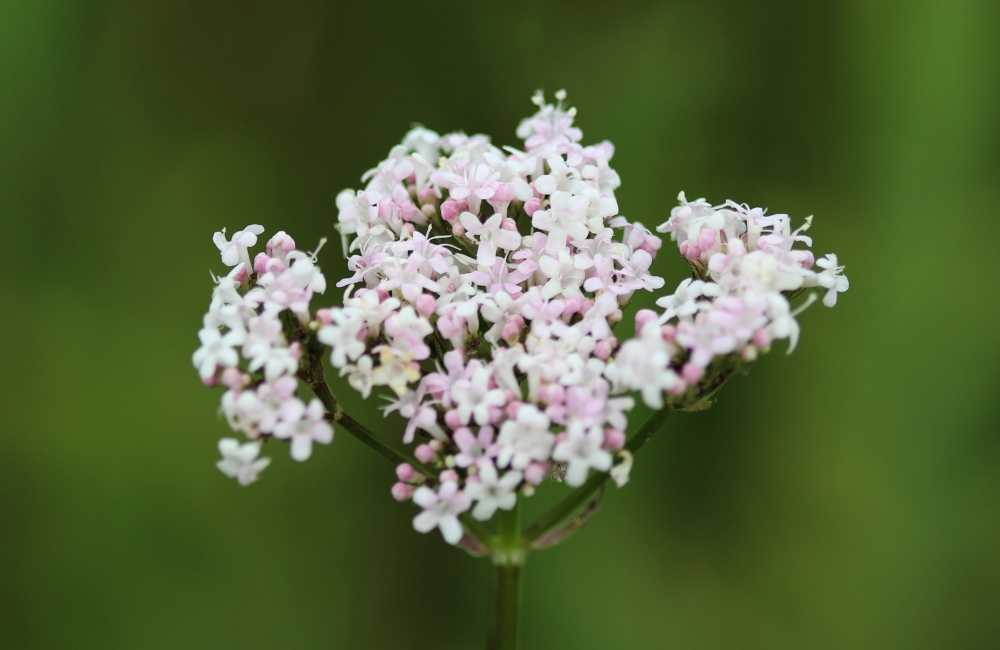Valerian root has so many great health benefits. Valerian (Valeriana officinalis), is a perennial, flowering plant native to Europe, America and parts of Asia. The plant is also known as an all-heal or garden heliotrope.
There are over 250 species of valerian, but the Valeriana officinalis is the specie most used in the West. It can grow up to 2 feet tall. It is usually grown to decorate gardens but also grows in wild in damp grasslands. Straight, hollow stems are topped by umbrella-like heads.
Its dark green leaves are pointed at the tip and hairy underneath. Small, sweet-smelling white, light purple, or pink flowers bloom in June. The root is light greyish brown and has a little odour when fresh. Valerian flowers have a delicate scent once used in perfumes.
Phytochemical Components of Valerian
Valerian consists of many biologically active components that account for its wide range of biological effects that make it beneficial to human health.
The chemical composition of Valarian varies greatly depending on the species, season, geographical source, growing condition, processing method and storage.
The three main bioactive components of valerian are as listed below:
- The Essential Oils: These are composed of valerenic acid and Valencell.
- Valepotriates
- Alkaloids: These include – Actinidine, Chatinine, Shyanthine, Valerianine, and Valerie.
Traditional Uses of Valerian Root
Traditionally, Valerian has been used to ease insomnia, anxiety, and nervous restlessness since the second century A.D. It has also been suggested to treat stomach cramps. Its use became popular in Europe in the 17th century.
 How Does Valerian Work?
How Does Valerian Work?
It is not so clear to researchers how Valerian works but it is believed to increase the amount of a chemical called gamma-aminobutyric acid (GABA) in the brain. This chemical helps to regulate nerve cells and has a calming effect on anxiety.
Drugs like diazepam (Valium) and alprazolam (Xanax) also work by increasing the effect but are milder. Valerian can be considered a popular and safer natural alternative to prescription medications for sleep disorders.
The compounds found in Valerian are responsible for sedating effects include:
- Valerenic Acid: This increases levels of GABA, a neurotransmitter that reduces brain cell activity. It also has anti-inflammatory effects.
- Iridoids: These are basically (valepotriates and their derivatives) and they have sedative effects, but are unstable and break down during storage or in water, making their activity difficult to assess.
- Isovaleric Acid: This prevents involuntary muscle contractions. This is just like the action of valproic acid used in the management of epilepsy.
- Hesperidia and Linarine: These are antioxidant flavonoids with sleep-enhancing effects. Hesperidin has anti-seizure effects.
Possible Health Benefits of Valerian Root
-
Use in Insomnia
What is insomnia? Insomnia is a common sleep disorder that can make it hard for you to fall asleep, hard to stay asleep or cause you to wake up too early and not be able to get back to sleep. You may still feel tired when you wake up. Valerian’s mild sedative effects have been used to promote relaxation and sleep for at least 2,000 years ago. Just as mentioned earlier, valerian may improve sleep by increasing GABA levels.
Lower GABA levels are usually found in people with short and long-term stress and are linked to anxiety and poor sleep quality.
It was discovered from research that valerian improved the speed of falling asleep, depth and overall quality of sleep.
Valerian may also help reduce sleep disturbances in a variety of health conditions like rheumatoid arthritis, menopause, hypothyroidism, PTSD, HIV, fibromyalgia and benzodiazepine withdrawal.
It is good to note that so far there has not been a well-designed clinical trial to support its effectiveness and safety beyond 4 to 6 weeks but its main benefit seems to be promoting natural sleep after several weeks of use, without the risk of dependence or negative health effects.
When used properly, it can serve as a gentler alternative to common insomnia drugs.
-
Menopausal Symptoms
Valerian root was seen to significantly improve sleep quality in menopausal women and equally improved the severity and frequency of hot flashes in postmenopausal women.
The above is still subject to more studies since there has not been any valid clinical evidence to support it.
-
Management of Anxiety
Valerian is nicknamed ‘nature’s valium’ because it supposedly has a similar effect on reducing anxiety as Valium and Xanax.
It was discovered in research that a high dose of valerian(1000mg/day) taken in combination with St John’s Wort(600mg/day) for about 6weeks reduced the symptoms of anxiety and depression by 66%.
Further studies are needed to clarify the potential benefits of valerian for anxiety.
-
Stress Management
Valerian was discovered to help in stress management by helping you have a good quality sleep, after which you are relaxed.
Valerian may also reduce physical reactions during stressful situations. It slowed heart rate and reduced blood pressure in response to stress.
-
Management of Attention-Deficit/Hyperactivity Disorder (ADHD)
ADHD is a chronic condition including attention difficulty, hyperactivity and impulsiveness. ADHD begins in childhood and can persist into adulthood. It may contribute to low self-esteem, troubled relationships and difficulty at school or work.
Valerian increases GABA levels in the brain and as mentioned before, deficiencies in GABA play a role in anxiety, restlessness, and obsessive behaviour, which are symptoms often seen in ADHD. With this increase in GABA, ADHD symptoms are improved. Valarian combined with lemon balm decreased symptoms of restlessness, concentration difficulties, and impulsiveness.
More research is needed to support the results of initial studies that proposed the effectiveness of valerian root for ADHD.
-
Menstrual Cramps
Because of the calming and relaxing effect of valerian, it is commonly used to treat uterine cramping associated with painful menstruation (dysmenorrhea).
-
Memory and Cognitive Function
Scientists observed the potential of valerenic acid to significantly improve memory by reducing oxidative stress in the memory centre of the brain.
-
Management of Fibromyalgia
This is a rheumatic condition characterized by muscular or musculoskeletal pain with stiffness and localized tenderness at specific points on the body. It is often triggered by an event that causes physical stress or emotional stress.
A valerian bath (3x a week for 3 weeks) was seen to significantly improve well-being, sleep and decreased pain in persons with fibromyalgia in a study.
-
Management of OCD
Obsessive-Compulsive Disorder (OCD) is a common neuropsychiatric condition. Psychiatrists often find that many patients cannot tolerate the side effects of psychiatrist medicine hence the quest to find an alternative in herbs.
Valerian is a well-known medicinal plant with a long history of usage in the world with effect on GABA and showed promising effects on the reduction of OCD
More research is needed as there is insufficient evidence to rate its effectiveness based on just one study.
-
Restless Leg Syndrome (RLS)
Valerian was found to significantly improve RLS symptoms and decreased daytime sleepiness. More research is still needed.
-
Wellbeing During Cancer and HIV Treatment
Fatigue was reduced in cancer patients undergoing therapy in a study while in another review, valerian improved insomnia and well-being in people undergoing treatment for cancer due to its calming effects. It did not interact with cancer drugs.
In HIV patients, the drug efavirenz used in patients with HIV is known to impair mental health and cause psychiatric disorders. Valerian root helped reduce insomnia and anxiety but failed to reduce psychosis and suicidal thoughts in a study conducted.
The available form of Valerian Root
- Valerian fluid extracts and tinctures are sold in alcohol or alcohol-free(glycerite) bases.
- Powdered valerian is available in capsule and tablet form and as tea.

Combinations of Valerian Root
Valerian root has a sharp odour. It is often combined with other calming herbs to mask the scent. These include:
- Passionflower (Passiflora incarnata)
- Hops (Humulus lupulus)
- Lemon balm (Melissa officinalis)
- Skullcap (Scutellaria lateriflora)
- Kava (Piper methysticum): This however has been associated with liver damage, so avoid it.
Precaution
Herbs are generally used with caution and valerian root is not an exception. The reason is that herbs can trigger side effects and can interact with other herbs, supplements, or medications.
- Valerian is generally regarded as safe but should be avoided in pregnant and nursing women.
- Some people may have paradoxical reactions to valerian, feeling anxious and restless after taking it instead of calm and sleepy.
- Valerian does not cause dependency nor does it cause withdrawal symptoms for most people but there have been few reports of withdrawal symptoms when valerian has been used over a very long period.
It is advised that if you want to stop taking valerian, lower your dose gradually rather than stopping all at once.
- Do not use valerian while driving, operating heavy machinery, or engaging in activities that require you to be alert.
- Do not use valerian for longer than 1 month without your healthcare provider’s approval.
Possible Interactions
If you are currently being treated with any of the following medications, you should not use valerian without talking to your health care provider:
-
Medications Broken Down by the Liver
Many medications rely on the liver to break them down, so it is possible that in such cases, too much of the drugs could build up in the system as valerian may slow down how quickly certain drugs are broken down by the liver.
-
Sedatives
Valerian can increase the effect of drugs or medications that can sedate you and they include:
- Anticonvulsants such as phenytoin and valproic acid
- Barbiturates
- Benzodiazepines such as alprazolam (Xanax) and diazepam (Valium)
- Drugs that treat insomnia, such as zolpidem, zaleplon, ramelteon and eszopiclone.
- Tricyclic antidepressants such as amitriptyline.
- Alcohol
- Herbs like chamomile, lemon balm and catnip.
-
Anaesthesia
Valerian may increase the effects of anaesthesia. You should let your doctor know that you are on valerian if you are going for surgery. You may be advised to gradually withdraw before the surgery or the anesthesiologist may make needed adjustments to the anaesthesia.
-
Other Drugs
Valerian is broken down by certain liver enzymes and therefore may interact with other drugs that are equally broken down by the same liver enzymes. These drugs include but may not be limited to the following:
- Antihistamines
- Statins (these are taken for high cholesterol)
- Some antifungal drugs.
Side Effects of Valerian Root
Valerian is likely safe when taken for 4 to 8 weeks by healthy adults at recommended doses. Long-term safety data are not available. In rare cases, it can cause mild side effects such as:
- Headaches
- Digestive upset
- Excitability
- Dry mouth
- Thinking problems
- Strange dreams
Conclusion
Valerian is nature’s valium! It is nature’s provision for a relaxed sleep without addiction. Traditionally for a long time, it has been used but more research is needed to back up traditional claims. Nature is wonderful! Always seeking balance! Valerian naturally does it!
Please consult your doctor to prescribe the right dosage for you if you want to try it. Take care to choose a product from a good manufacturer. This write-up is not intended for you to self-medicate or stop your prescription drugs without first consulting your doctor. Thank you!

